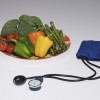 Our bodies are made up of cells. Chemical reactions necessary for life are constantly occurring inside our cells, and sometimes they create free radicals — highly reactive molecules that can initiate damaging chain reactions known as oxidative stress.
Our bodies are made up of cells. Chemical reactions necessary for life are constantly occurring inside our cells, and sometimes they create free radicals — highly reactive molecules that can initiate damaging chain reactions known as oxidative stress.
Antioxidants can inactivate free radicals and protect our cells from oxidative stress and the damage it causes. Antioxidants also can help our immune system defend against bacteria, fungi, viruses, and some cancers. The body produces some of its own antioxidants, but eating a plant-based diet increases the level of antioxidants in our bodies. This 3-page fact sheet was written by Kaitlin G. Clark and Wendy J. Dahl, and published by the UF Department of Food Science and Human Nutrition, February 2014.
http://edis.ifas.ufl.edu/fs242
Tag: Wendy Dahl
Facts about Carbohydrate
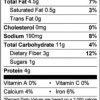 Carbohydrate, fat, and protein are the three nutrients that provide energy (calories). However, carbohydrate from starch and sugars is our main and most important source of energy. During digestion, starch is broken down to sugar (glucose). Carbohydrate in the form of glucose provides energy to cells, tissues, and organs to carry out daily activities. Some glucose is stored in the liver and muscle cells for later use when required. Children need carbohydrate for growth, and adults need carbohydrate to maintain their weight. This 3-page fact sheet was written by Nancy J. Gal, Amanda L. Ford, and Wendy J. Dahl, and published by the UF Department of Food Science and Human Nutrition, February 2014.
Carbohydrate, fat, and protein are the three nutrients that provide energy (calories). However, carbohydrate from starch and sugars is our main and most important source of energy. During digestion, starch is broken down to sugar (glucose). Carbohydrate in the form of glucose provides energy to cells, tissues, and organs to carry out daily activities. Some glucose is stored in the liver and muscle cells for later use when required. Children need carbohydrate for growth, and adults need carbohydrate to maintain their weight. This 3-page fact sheet was written by Nancy J. Gal, Amanda L. Ford, and Wendy J. Dahl, and published by the UF Department of Food Science and Human Nutrition, February 2014.
http://edis.ifas.ufl.edu/fs243
Facts about Flavonoids
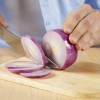 Flavonoids are organic compounds that occur naturally in plants. More than five thousand flavonoid compounds exist in nature, but those found in foods fall into six major categories: flavonols, anthocyanidins, isoflavones, flavan-3-ols, flavones, and flavonones. The compounds in these categories are of interest because of their potential health benefits. This 4-page fact sheet was written by Inbar Schapsis and Wendy J. Dahl, and published by the UF Department of Food Science and Human Nutrition, February 2014.
Flavonoids are organic compounds that occur naturally in plants. More than five thousand flavonoid compounds exist in nature, but those found in foods fall into six major categories: flavonols, anthocyanidins, isoflavones, flavan-3-ols, flavones, and flavonones. The compounds in these categories are of interest because of their potential health benefits. This 4-page fact sheet was written by Inbar Schapsis and Wendy J. Dahl, and published by the UF Department of Food Science and Human Nutrition, February 2014.
http://edis.ifas.ufl.edu/fs244
Los alimentos hechos en pure, las bebidas espesadas y las necesidades de agua
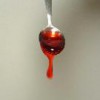 El consumo adecuado del agua puede ser un problema para algunas personas con problemas de tragar, especialmente para aquellos que tienen dificultad para tragar los líquidos ligeros. Los ejemplos de líquidos ligeros son el agua, la leche, el café, el té, y la mayoría de los jugos de frutas. This 4-page fact sheet was written by Wendy J. Dahl, and published by the UF Department of Food Science and Human Nutrition, January 2014.
El consumo adecuado del agua puede ser un problema para algunas personas con problemas de tragar, especialmente para aquellos que tienen dificultad para tragar los líquidos ligeros. Los ejemplos de líquidos ligeros son el agua, la leche, el café, el té, y la mayoría de los jugos de frutas. This 4-page fact sheet was written by Wendy J. Dahl, and published by the UF Department of Food Science and Human Nutrition, January 2014.
http://edis.ifas.ufl.edu/fs241
Frijoles, guisantes, y lentejas: Beneficios de la Salud
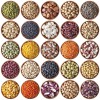 Los frijoles, los guisantes y las lentejas son conocidos colectivamente como legumbres. Los frijoles son una gran fuente de muchos nutrientes, incluyendo proteína, fibra y potasio. This 2-page fact sheet was written by Lakshmi Mahan, Lauren Foster, and Wendy J. Dahl, and published by the UF Department of Food Science and Human Nutrition, January 2014.
Los frijoles, los guisantes y las lentejas son conocidos colectivamente como legumbres. Los frijoles son una gran fuente de muchos nutrientes, incluyendo proteína, fibra y potasio. This 2-page fact sheet was written by Lakshmi Mahan, Lauren Foster, and Wendy J. Dahl, and published by the UF Department of Food Science and Human Nutrition, January 2014.
http://edis.ifas.ufl.edu/fs240
Los alimentos en pure y la fibra
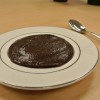 La fibra es importante para la buena salud. El consumo inadecuado de fibra puede conducir al estreñimiento y a otros problemas gastrointestinales. Las dietas altas en fibra pueden ayudar a reducir el colesterol y la glucosa en la sangre, lo que reduce el riesgo de las enfermedades del corazón. Aunque la fibra se encuentra en todos los alimentos de origen vegetal como las frutas, los vegetales, los granos, las nueces y las semillas, la mayoría de las personas no consumen lo suficiente.The English version of this document is FSHN12-16/FS209 Puréed Foods and Fiber. This 4-page fact sheet was written by Wendy J. Dahl, and published by the UF Department of Food Science and Human Nutrition, December 2013.
La fibra es importante para la buena salud. El consumo inadecuado de fibra puede conducir al estreñimiento y a otros problemas gastrointestinales. Las dietas altas en fibra pueden ayudar a reducir el colesterol y la glucosa en la sangre, lo que reduce el riesgo de las enfermedades del corazón. Aunque la fibra se encuentra en todos los alimentos de origen vegetal como las frutas, los vegetales, los granos, las nueces y las semillas, la mayoría de las personas no consumen lo suficiente.The English version of this document is FSHN12-16/FS209 Puréed Foods and Fiber. This 4-page fact sheet was written by Wendy J. Dahl, and published by the UF Department of Food Science and Human Nutrition, December 2013.
http://edis.ifas.ufl.edu/fs238
Facts about Fructose
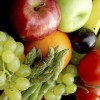 Fructose is a simple sugar found in many foods. Common table sugar is made of equal amounts fructose and glucose. Similarly, high-fructose corn syrup, commonly used to sweeten foods, contains a mixture of fructose and glucose. Fructose is sweeter than glucose, and for this reason it has been used in many sweetened foods. This 2-page fact sheet was written by Wendy Dahl, Lauren Foster, and Russel Owen, and published by the UF Department of Food Science and Human Nutrition, June 2013.
Fructose is a simple sugar found in many foods. Common table sugar is made of equal amounts fructose and glucose. Similarly, high-fructose corn syrup, commonly used to sweeten foods, contains a mixture of fructose and glucose. Fructose is sweeter than glucose, and for this reason it has been used in many sweetened foods. This 2-page fact sheet was written by Wendy Dahl, Lauren Foster, and Russel Owen, and published by the UF Department of Food Science and Human Nutrition, June 2013.
http://edis.ifas.ufl.edu/fs148
Facts about Phosphorus
 Phosphorus is a mineral found in every cell of the body, usually in the form of phosphate. It is the second most abundant mineral in the body after calcium. About 85% of phosphorus is stored in the bones and teeth. It is important for forming bones and teeth, as well as repairing bones. This 3-page fact sheet was written by Nancy J. Gal and Wendy J. Dahl, and published by the UF Department of Food Science and Human Nutrition, January 2014.
Phosphorus is a mineral found in every cell of the body, usually in the form of phosphate. It is the second most abundant mineral in the body after calcium. About 85% of phosphorus is stored in the bones and teeth. It is important for forming bones and teeth, as well as repairing bones. This 3-page fact sheet was written by Nancy J. Gal and Wendy J. Dahl, and published by the UF Department of Food Science and Human Nutrition, January 2014.
http://edis.ifas.ufl.edu/fs237
Shopping for Health: Foods with Added Fiber
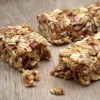 Fiber in foods consists of carbohydrates that cannot be digested. Although many foods naturally contain fiber, high-fiber ingredients are commonly added to foods to increase their fiber content. Fiber ingredients may be added to foods for health or functional reasons. This 3-page fact sheet was written by Wendy Dahl, and published by the UF Department of Food Science and Human Nutrition, November 2013.
Fiber in foods consists of carbohydrates that cannot be digested. Although many foods naturally contain fiber, high-fiber ingredients are commonly added to foods to increase their fiber content. Fiber ingredients may be added to foods for health or functional reasons. This 3-page fact sheet was written by Wendy Dahl, and published by the UF Department of Food Science and Human Nutrition, November 2013.
http://edis.ifas.ufl.edu/fs235
Beans, Peas, and Lentils: Health Benefits (FSHN1306/FS229)
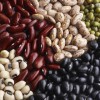 Bean, peas, and lentils are known collectively as legumes or pulses. Beans are great sources of many nutrients, including protein, fiber, and potassium. They can be placed either in the vegetable group or the protein group of MyPlate. If you have consumed enough protein choices, then you can count them in the vegetable group, and vice versa. This 2-page fact sheet was written by Lakshmi Mahan, Lauren Foster, and Wendy J. Dahl, and published by the UF Department of Food Science and Human Nutrition, May 2013.
Bean, peas, and lentils are known collectively as legumes or pulses. Beans are great sources of many nutrients, including protein, fiber, and potassium. They can be placed either in the vegetable group or the protein group of MyPlate. If you have consumed enough protein choices, then you can count them in the vegetable group, and vice versa. This 2-page fact sheet was written by Lakshmi Mahan, Lauren Foster, and Wendy J. Dahl, and published by the UF Department of Food Science and Human Nutrition, May 2013.
http://edis.ifas.ufl.edu/fs229
Growing Potatoes in the Florida Home Garden (HS993/HS183)
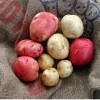 The Irish potato is a cool-season crop. A recently grown and harvested potato exhibits different flavor profiles from one that has been in storage or on a grocery shelf for an extended period. For example, in storage, the starches in potatoes convert to sugars, resulting in a less desirable texture and taste. “New” potato flavor can be achieved in the home garden by following a few growing recommendations. This 9-page fact sheet was written by Christian T. Christensen, Libby R. Rens, Jeffrey E. Pack, Lincoln Zotarelli, Chad Hutchinson, Wendy Dahl, Doug Gergela, and James M. White, and published by the UF Department of Horticultural Sciences, April 2013.
The Irish potato is a cool-season crop. A recently grown and harvested potato exhibits different flavor profiles from one that has been in storage or on a grocery shelf for an extended period. For example, in storage, the starches in potatoes convert to sugars, resulting in a less desirable texture and taste. “New” potato flavor can be achieved in the home garden by following a few growing recommendations. This 9-page fact sheet was written by Christian T. Christensen, Libby R. Rens, Jeffrey E. Pack, Lincoln Zotarelli, Chad Hutchinson, Wendy Dahl, Doug Gergela, and James M. White, and published by the UF Department of Horticultural Sciences, April 2013.
http://edis.ifas.ufl.edu/hs183
El sobrepeso y el mantenimiento de la perdida de peso (FSHN1304S/FS228)
 Para muchas personas, la pérdida de peso es una batalla crónica. Las dietas populares a menudo son poco exitosas porque no se pueden seguir de forma permanente. No hay una dieta mágica que le pueda hacer bajar de peso inmediatamente, pero a continuación se enumeran algunos buenos consejos para la pérdida de peso de una manera estable y de largo plazo. This 3-page fact sheet was written by Anne Mathews, Lauren Foster, and Wendy Dahl, and published by the UF Department of Food Science and Human Nutrition, April 2013.
Para muchas personas, la pérdida de peso es una batalla crónica. Las dietas populares a menudo son poco exitosas porque no se pueden seguir de forma permanente. No hay una dieta mágica que le pueda hacer bajar de peso inmediatamente, pero a continuación se enumeran algunos buenos consejos para la pérdida de peso de una manera estable y de largo plazo. This 3-page fact sheet was written by Anne Mathews, Lauren Foster, and Wendy Dahl, and published by the UF Department of Food Science and Human Nutrition, April 2013.
http://edis.ifas.ufl.edu/fs228
De compras para la salud: Vegetales (FSHN1305/FS227)
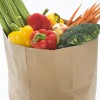 Escoger los vegetales correctos le ayudará a obtener los nutrientes que su cuerpo necesita cada día. Con tantas opciones, ir a comprar vegetales puede parecer una tarea difícil, pero no lo tiene que ser. Este artículo le ayudará a volverse un comprador inteligente de vegetales. This 3-page fact sheet was written by Ashley R. Kendall y Wendy Dahl, and published by the UF Department of Food Science and Human Nutrition, April 2013.
Escoger los vegetales correctos le ayudará a obtener los nutrientes que su cuerpo necesita cada día. Con tantas opciones, ir a comprar vegetales puede parecer una tarea difícil, pero no lo tiene que ser. Este artículo le ayudará a volverse un comprador inteligente de vegetales. This 3-page fact sheet was written by Ashley R. Kendall y Wendy Dahl, and published by the UF Department of Food Science and Human Nutrition, April 2013.
http://edis.ifas.ufl.edu/fs227
MiPlato para los problemas de deglucion: Disfagia (FSHN1214S/FS223)
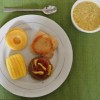 MiPlato es el ícono de los lineamientos alimentarios del Departamento de Agricultura de los Estados Unidos basado en las Guías Alimentarias del 2010 para los Estadounidenses. Es una imagen fácil de entender que se enfoca en la creación de un plato con alimentos saludables. Los recursos y herramientas en ChooseMyPlate.gov ofrece información clara y factible acerca de cómo escoger mejor alimentos que se pueden adaptar a personas con dificultades de deglución (disfagia) que requieren de alimentos con textura modificada. Aunque los alimentos magros y los alimentos bajos en grasa son recomendados, aquellos con dificultades de deglución pueden necesitar añadir la grasa a algunos alimentos para mejorar la aceptabilidad, la facilidad de deglución y también para ayudarlos a satisfacer sus necesidades de energía. This 3-page fact sheet was written by Jamila R. Lepore, Nancy J. Gal, and Wendy Dahl, and published by the UF Department of Food Science and Human Nutrition, April 2013.
MiPlato es el ícono de los lineamientos alimentarios del Departamento de Agricultura de los Estados Unidos basado en las Guías Alimentarias del 2010 para los Estadounidenses. Es una imagen fácil de entender que se enfoca en la creación de un plato con alimentos saludables. Los recursos y herramientas en ChooseMyPlate.gov ofrece información clara y factible acerca de cómo escoger mejor alimentos que se pueden adaptar a personas con dificultades de deglución (disfagia) que requieren de alimentos con textura modificada. Aunque los alimentos magros y los alimentos bajos en grasa son recomendados, aquellos con dificultades de deglución pueden necesitar añadir la grasa a algunos alimentos para mejorar la aceptabilidad, la facilidad de deglución y también para ayudarlos a satisfacer sus necesidades de energía. This 3-page fact sheet was written by Jamila R. Lepore, Nancy J. Gal, and Wendy Dahl, and published by the UF Department of Food Science and Human Nutrition, April 2013.
http://edis.ifas.ufl.edu/fs223
Overweight and Weight Loss Maintenance (FSHN1304/FS226)
 For many people, weight loss is a chronic battle. Popular diets are often unsuccessful because they cannot be followed permanently. There is no magic diet to make you instantly shed pounds, but some good tips for steady, long-term weight loss are listed in this 2-page fact sheet written by Anne Mathews, Lauren Foster, and Wendy Dahl, and published by the UF Department of Food Science and Human Nutrition, February 2013.
For many people, weight loss is a chronic battle. Popular diets are often unsuccessful because they cannot be followed permanently. There is no magic diet to make you instantly shed pounds, but some good tips for steady, long-term weight loss are listed in this 2-page fact sheet written by Anne Mathews, Lauren Foster, and Wendy Dahl, and published by the UF Department of Food Science and Human Nutrition, February 2013.
http://edis.ifas.ufl.edu/fs226
Shopping for Health: Herbs and Spices (FSHN1303/FS225)
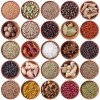 Herbs and spices have been used for hundreds of years in cooking and medicine. They add a wide range of flavors to food and may also provide health benefits. For some people, using herbs and spices in cooking may be a challenge, but it doesn’t have to be that way! The information below will get you on track to enjoying zesty, flavorful, healthy cooking.This 4-page fact sheet was written by Jenna A. Norris and Wendy Dahl, and published by the UF Department of Food Science and Human Nutrition, April 2013.
Herbs and spices have been used for hundreds of years in cooking and medicine. They add a wide range of flavors to food and may also provide health benefits. For some people, using herbs and spices in cooking may be a challenge, but it doesn’t have to be that way! The information below will get you on track to enjoying zesty, flavorful, healthy cooking.This 4-page fact sheet was written by Jenna A. Norris and Wendy Dahl, and published by the UF Department of Food Science and Human Nutrition, April 2013.
http://edis.ifas.ufl.edu/fs225
Shopping for Health: A Menu for One (FSHN1302/FS224)
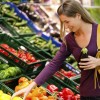 In today’s busy world, many Americans find themselves cooking meals for one. Older adults and college students alike face the challenge of making meal preparation a priority when no one else is depending on them to create a balanced meal. Whether you pop a dish into the microwave after a busy day or spend time cooking a special meal for yourself, shopping for and preparing healthy, low-cost meals for one can be easy and enjoyable with just a little bit of planning. This 4-page fact sheet was written by Morgan Denhard and Wendy Dahl, and published by the UF Department of Food Science and Human Nutrition, February 2013.
In today’s busy world, many Americans find themselves cooking meals for one. Older adults and college students alike face the challenge of making meal preparation a priority when no one else is depending on them to create a balanced meal. Whether you pop a dish into the microwave after a busy day or spend time cooking a special meal for yourself, shopping for and preparing healthy, low-cost meals for one can be easy and enjoyable with just a little bit of planning. This 4-page fact sheet was written by Morgan Denhard and Wendy Dahl, and published by the UF Department of Food Science and Human Nutrition, February 2013.
http://edis.ifas.ufl.edu/fs224
Guia de merendar saludablemente para el adulto mayor fragil (FSHN1219S/FS222)
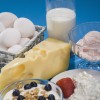 El tomar decisiones inteligentes para la selección de las meriendas ayuda a asegurar que los adultos mayores frágiles satisfagan sus necesidades nutricionales. Estas son algunas meriendas sencillas y nutritivas que son apropiadas para los adultos mayores frágiles. This 3-page fact sheet was written by Paula G. Harris-Swiatko y Wendy J. Dahl, and published by the UF Department of Food Science and Human Nutrition, April 2013.
El tomar decisiones inteligentes para la selección de las meriendas ayuda a asegurar que los adultos mayores frágiles satisfagan sus necesidades nutricionales. Estas son algunas meriendas sencillas y nutritivas que son apropiadas para los adultos mayores frágiles. This 3-page fact sheet was written by Paula G. Harris-Swiatko y Wendy J. Dahl, and published by the UF Department of Food Science and Human Nutrition, April 2013.
http://edis.ifas.ufl.edu/fs222
Carbohydrate Counting: Meals for Diabetes (FSHN1218/FS212)
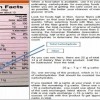 “Carb” counting is a way to plan meals to help you maintain target blood glucose levels. Certain foods contain carbohydrate, and these are the foods that most influence your blood glucose. Your body needs carbohydrate in just the right amount. Not enough carbohydrate can lead to low blood glucose (hypoglycemia). Too much carbohydrate can lead to high blood glucose (hyperglycemia). This is why carb counting is a great tool to understand and practice because it can help you control your blood glucose and still give you the freedom to make varied food choices. This 4-page fact sheet was written by Cassie Rowe, Jamila R. Lepore, and Wendy J. Dahl, and published by the UF Department of Food Science and Human Nutrition, March 2013.
“Carb” counting is a way to plan meals to help you maintain target blood glucose levels. Certain foods contain carbohydrate, and these are the foods that most influence your blood glucose. Your body needs carbohydrate in just the right amount. Not enough carbohydrate can lead to low blood glucose (hypoglycemia). Too much carbohydrate can lead to high blood glucose (hyperglycemia). This is why carb counting is a great tool to understand and practice because it can help you control your blood glucose and still give you the freedom to make varied food choices. This 4-page fact sheet was written by Cassie Rowe, Jamila R. Lepore, and Wendy J. Dahl, and published by the UF Department of Food Science and Human Nutrition, March 2013.
http://edis.ifas.ufl.edu/fs212
Pureed Foods: High Protein (FSHN1215/FS208)
 Protein is an important nutrient. Many older adults do not consume enough of this vital nutrient, crucial to overall health and well-being. For those with dysphagia and on a puréed diet, consuming sufficient protein is even more difficult. While a texture-modified diet may not be the diet of choice, the goal is to make it as appealing as possible so that the person consuming the purées can experience a better quality of life. This 4-page fact sheet was written by Jamila R. Lepore and Wendy J. Dahl, and published by the UF Department of Food Science and Human Nutrition, March 2013.
Protein is an important nutrient. Many older adults do not consume enough of this vital nutrient, crucial to overall health and well-being. For those with dysphagia and on a puréed diet, consuming sufficient protein is even more difficult. While a texture-modified diet may not be the diet of choice, the goal is to make it as appealing as possible so that the person consuming the purées can experience a better quality of life. This 4-page fact sheet was written by Jamila R. Lepore and Wendy J. Dahl, and published by the UF Department of Food Science and Human Nutrition, March 2013.
http://edis.ifas.ufl.edu/fs208